Kerala Plus One Botany Chapter Wise Previous Questions Chapter 5 Cell The Unit of Life
Question 1.
a) Choose from the bracket, the name of the part of a bacterial cell that constitutes extra genomic DNA (mesosome/ plasmid/ basal body) (MARCH-2010)
b) Write any one of its functions.
c) Comment on its practical application.
Answer:
a) plasmid
b) it is used in sexual reproduction
c) It is used as cloning vector in genetic engineering.
Question 2.
Cell membrane is comprised of lipids and protein. Membrane protein mediate transfer of molecules across it. (SAY-2010)
a) Suggest a model of membrane constitution that is suitable for this function.
b) Give the name of scientist who proposed it.
Answer:
a) Fluid mosaic model
b) Singer & Nicolson
Question 3.
State the reason for the following. (SAY-2010)
a) Mitochondria are called the power houses of the cell.
b) A metabolic product from cytoplasm is needed for energy production in mitichondria.
Answer:
a) Energy production, storage & liberation takesplace
b) Pyruvic acid / Production of NADPH2 / Formation of Acetyl co.A
Question 4.
Eukaryotic cells have any membrane bound or-ganelles like endoplasmic recticulum, golgicomplex, mitochondria etc. Can you give an example of a nonmembrane bound organelle? (MARCH-2011)
Answer:
Ribosome
Question 5.
Plastids are found in all plant cells and in euglenoides. Draw a diagram of the chlroplast and label the following parts: (MARCH-2011)
a) Grana
b) Stroma
c) Tylakoid
d) Stroma lamella
Answer:
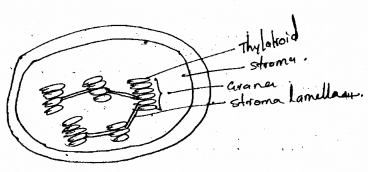
Question 6.
Examine the diagram of a eukaryotic cell. Which one of the labelled cell organelles is present in bacteria? Membrane extensions into the bacterial cell is called mesosomes. What are their forms and function? (SAY-2011)

Answer:
Ribosome,
Mesosome
These extensions are in the form of vesicles, tubules and lamellae
They helps in wall formation
DNA replication and distribution to daughter cells
Respiration
Secretion and increase the surface area of the plasma Membrane and enzymatic content.
Question 7.
a) Identify the cell organelle found both in eukary-otic and prokaryotic cells. (MARCH-2012)
b) Justify its presence in both types of cells.
Answer:
a) Ribosome
b) It is used in Protein synthesis
Question 8.
Match the following: (MARCH-2012)
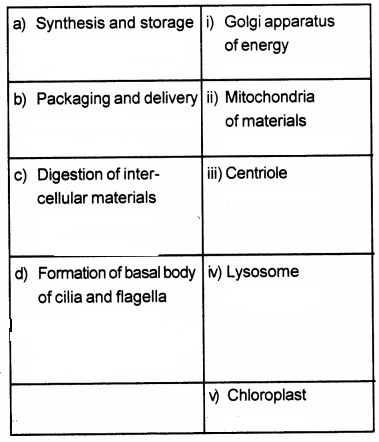
Answer:
a) Synthesis and storage of energy – Mitochondria
b) Packaging and delivery of materials – Golgi apparatus
c) Digestion of intercellular materials – Lysosome
d) Formation of basal body of cillia and flagella – Centriole
Question 9.
The following is a list of cell organelles (nucleus, endoplasmic reticulum, lysosomes, chloroplast, golgi complex, mitochondria, ribosome) (SAY-2012)
a) Identify the organelles with double membrane envelope. .
Cell – The Unit of Life
b) Mention the functions of these organelles.
Answer:
a) Nucleus,
Mitochondria,
Chloroplast
b) Nucleus – Controlling centre of all the activities of the cell.
Mitochondria – Production of energy.
Chloroplast – Photosynthesis
Question 10.
Observe the given relation and fill in the blanks. (MARCH-20103)
Starch : Amyloplast : :
Fat: …………..
Answer:
Elaioplast
Question 11.
An accepted model of the structure of a cell mem-brane was proposed by Singer and Nicolson. (MARCH-2013)
a) Name the model.
b) List the 2 major biomolecules which this mem-brane is composed of.
c) Mention two important points of this model from the point of view of function.
Answer:
a) fluid mosaic model
b) lipid and protein
c) 1) cell growth
2) formation of intercellular junctions
Question 12.
The diagrams a, b, c given below show three kinds of chromosomes. Of this, which is metacentric non-satellite chromosome. Justify your answer. (SAY-2013)
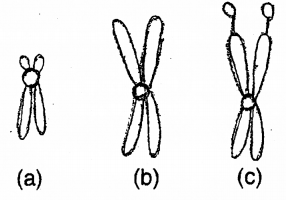
Answer:
Diagram b is the metacentric non satellite chromosome
Question 13.
Prokaryotic cells possess a special membranous structure which is formed by the extensions of the plasma membrane in the form of vesicles, tubules and lamellae. Identify this structure and write any one of its functions. (MARCH-2014)
Answer:
Mesosome. It helps in wall formation, secretion and respiration.
Question 14.
State whether the statements are ’true’ or ‘false’. If ‘false’, correct the statements by changing the un-derlined words. (MARCH-2014)
a) Aleuroplasts store carbohydrates.
b) The centrioles form the basal body of cilia and flagella.
c) Ribosomes are not surrounded by membranes.
d) RER is the major site for synthesis of lipids.
Answer:
a) False, it store proteins
b) True
c) True
d) False, it is involved in the production of proteins
Question 15.
In which hydrolases, the membrane bound vesicles are present? (SAY-2014)
Answer:
Lysosome contains acid hydrolases
Question 16.
Distinguish between the characters of chloroplast and ribsomes from the given list and write them in appropriate columns. (SAY-2014)
(Double membrane, George Palade, sac-like thylakoid, 70 Sand 80 S).
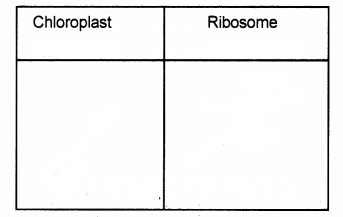
Answer:
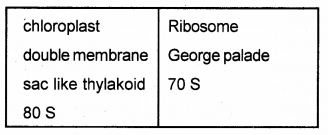
Question 17.
a) Due to the presence of a secondary construction, a knob-like small fragment appears in some chromosomes called (MARCH-2015)
i) Kinetochore
ii) Histone
iii) Satellite
iv) Chiasmata
b) Classify chromosomes based on the position of centromere.
Answer:
a) iii) Satellite
b) Metacentric – Median centromere
Sub metacentric – Submedian centromere
Acrocentric – Subterminal centromere
Telocentric – Terminal centromere
Question 18.
Several ribosomes may attach to a single mRNAand form a chain called ………….. (SAY-2015)
Answer:
polyribosome
Question 19.
Name the type of chromosome based on the position of centromere in the figure and label the parts A, Band C. (SAY-2015)

Answer:
Metacentric chromosome
a – centromere, b – secondary constriction,c – satellite
Question 20.
Observe the given diagram. Analyze this diagram and explain the structure of plasma membrane. (MARCH-2016)
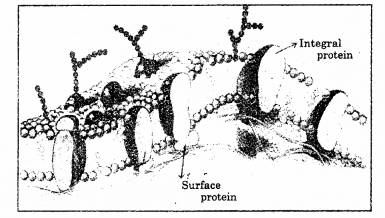
Answer:
It consist of lipid bilayer They are arranged within the membrane with the polar head towards the outer sides and the hydrophobic tails towards the inner part. The peripheral proteins lie on the surface of membrane while the integral proteins are buried in the membrane.
Question 21.
Identify the cell organell known as ‘powerhouse’ of the cell from those given below, (SAY-2016)
a) Lysosome
b) Centrosome
c) Mitochondria
d) Plastid
Answer:
c) Mitochondria
Question 22.
Ribosome is the cell organell seen in both prokaryotes and eukaryotes. Mention how ribosomes differ in prokaryotes and eukaryotes. Also mention the function of ribosome. (SAY-2016)
Answer:
In prokaryotes- 70 S type
In eukaryotes – 80S type
Ribosomes are involved in Protein synthesis
Question 23.
a) Identify a call organic which contains hydrolytic enzymes. (MARCH-2017)
b) Rough Endoplasmic Reticulum (RER) and Smooth Endoplasmic Reticulum (SER) are morphologically and functionally different. Justify this statement.
Answer:
a) Lysosomes
b) The endoplasmic reticulum bearing ribosomes on their surface is called rough endoplasmic reticulum (RER)
It is involved in protein synthesis and secretion In the absence of ribosomes ER appear smooth are called us smooth endoplasmic reticulum (SER).
It is the major site for synthesis of lipid. In animals steroid hormones are synthesized
